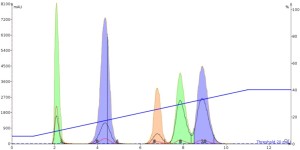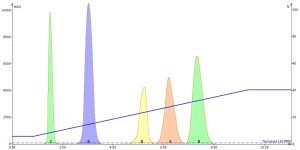In a previous post I talked about column size, specifically long-thin versus short-fat and the impact of the cartridge’s dimensions on purification performance. With that comparison I showed that in preparative chromatography, purification efficiency is more about the amount of silica than column dimensions. Cartridges of different dimensions containing the same amount of the same media will provide the same separation efficiency.
But there are other chromatographic aspects where size can impact performance. In this post I will focus on some areas where size does matter – media particle size and media surface area.
We all know that a chromatography column’s ability to fully separate any pair of compounds relies primarily on two basic parameters – selectivity and efficiency. Without elution conditions (solvent and media) that selectively elute one compound faster than another, there is no separation. Once the selectivity is optimized (refer to my previous post on optimization for more information), then maximizing efficiency (column plate count) becomes important because it impacts resolution and resolution impacts loading capacity.
For flash purification, the majority of chemists use traditional flash-grade media - a nominal 50 µm particle with about 500 m2/g of surface area and a 60Å pore diameter. For decades this has been the standard because it is a media that provides suitable resolution (load), is readily available in pre-packed columns and in bulk, and is relatively inexpensive.
Today, however, chemists (and their employers) want to reduce synthesis costs and one way is to reduce flash chromatography solvent consumption and purification time (yes, flash chromatography is a synthesis tool). To do this all you need to do is increase the amount of crude reaction mix that can be purified on a flash column. Sounds simple and it really is.
Your standard 50 µm particle size media columns may purify the amount of product you need but they require more media and therefore more solvent than a column packed with media with, let’s say ½ the particle size – 25 µm. Cutting the media particle size in half will double the efficiency, increase resolution and therefore increase load size. But reducing particle size takes you only so far – cutting it in half doubles plate count but does not double sample load!
Why not? Well, resolution is a product of three variables – efficiency, selectivity, and compound retention as seen in the equation below where Rs is resolution, α is selectivity, and k2 is the compound retention (aka capacity factor).
Rs = √N/4*(α-1/α)*(k2/k2+1)
So, from this equation it is easy to see that resolution is directly proportional to the square root of efficiency divided by 4. In other words, you need to increase efficiency 4x to double resolution or double loading capacity, see the table below to see what is required to double resolution. As the table below shows, halving the particle size increases resolution by 40%. Dropping to a 15 µm media will almost get you there increasing resolution 80%, but still will not double the capacity. So what about even smaller particles – 10 µm, 5 µm? Sure, they will increase resolution further – as well as backpressure and cartridge cost – likely too much pressure for plastic cartridges to tolerate.
| dp (µm) | k'1 | k'2 | α | N/m | √N | Rs | % Increase |
| 50 | 6.5 | 8 | 1.23 | 8,000 | 20.98 | 0.87 | |
| 25 | 6.5 | 8 | 1.23 | 16,000 | 29.66 | 1.24 | 41% |
| 15 | 6.5 | 8 | 1.23 | 26,667 | 38.30 | 1.60 | 83% |
But there is another way to increase cartridge load capacity without breaking the cartridge, or your budget, increasing media surface area. If you think about this it makes sense. The more surface area the media has the more surface there is available for sample to adsorb therefore increasing the media loading capacity – this is a direct correlation.
One flash column manufacturer, Biotage, has added high surface area silica columns into its cartridge product line. This media has about 750 m2/g of accessible surface area – 50% more than traditional silica – which can increase loading capacity 2x over conventional 500 m2/g silica for the same particle size silica. Biotage also has this high surface area silica in a 20 µm particle which has been shown to increase loading capacity 3 to 4x over conventional 50 µm, 500 m2/g silica - a much more effective change than lowering particle size alone. The impact of changing your purification columns to those packed with really high surface area silica like mentioned here is the potential to purify the same amount of compound with less silica using less solvent and in less time. Or, as the data below shows, increase sample load 2x and still achieve a better separation with the same cartridge size.

A conventional 50 μm, 500 m2/g, 10 g silica column (Biotage KP-Sil) purification of 100 mg of a 5-component sample generates an acceptable separation though the last two peaks are not fully resolved.

Have you tried any of these high surface area columns? Have you experienced different results?
Are there other topics you would like to see discussed?
Please download our white paper, Successful Flash Chromatography, if you would like learn more about this purification technique.

 Organic Workflow
Organic Workflow Peptide Workflow
Peptide Workflow Scale-Up Flash Purification
Scale-Up Flash Purification  Sample Preparation
Sample Preparation Biomolecule Purification
Biomolecule Purification Oligo synthesis
Oligo synthesis Scavengers and Reagents
Scavengers and Reagents Service & Support
Service & Support Accessories & Spare parts
Accessories & Spare parts Investors
Investors Reports & News
Reports & News The Share
The Share Corporate Governance
Corporate Governance Calendar
Calendar Sustainability
Sustainability Our Offering
Our Offering Our History
Our History Our Locations
Our Locations Leadership
Leadership